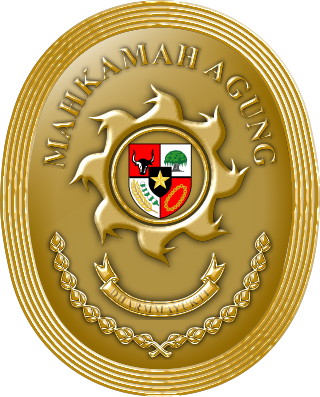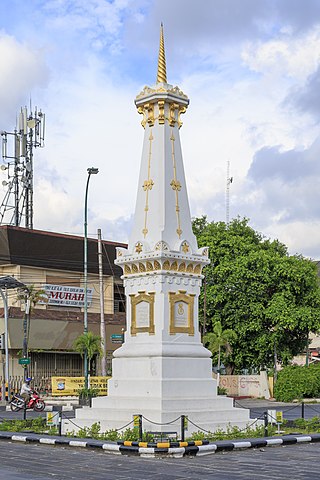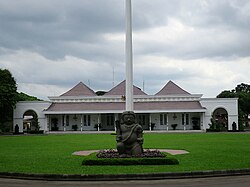
The National Monument is a 132 m (433 ft) obelisk in the centre of Merdeka Square, Central Jakarta, symbolizing the fight for Indonesia. It is the national monument of the Republic of Indonesia, built to commemorate the struggle for Indonesian independence.

Istana Negara is one of the six presidential palaces of Indonesia. It is located on Veteran Street in Central Jakarta, with Merdeka Palace located south. It is part of the presidential palace compound which has a total area of 68,000 m², along with three other buildings: Bina Graha that was formerly used as the President's Office, Wisma Negara in the western side which is used as state guest house, and the office for the Ministry of State Secretariat of Indonesia. Istana Negara faces north towards aforementioned street, while the Merdeka Palace faces Merdeka Square and the National Monument (Monas).

The Merdeka Palace, is one of six presidential palaces in Indonesia. It is located on the north side of the Merdeka Square in Central Jakarta, Indonesia and is used as the official residence of the president of the Republic of Indonesia.

Herman Johannes was an Indonesian professor, scientist, politician and National Hero. Johannes was the rector of Universitas Gadjah Mada in Yogyakarta (1961–1966), Coordinator for Higher Education from 1966 to 1979, a member of Indonesia's Presidential Supreme Advisory Council from 1968 to 1978, and the Minister for Public Works and Energy (1950–1951). He was also a member of the Executive Board of UNESCO from 1954 to 1957.

Fort Vredeburg Museum was a former colonial fortress located in the city of Yogyakarta. The military complex has been converted into a museum of the Indonesian independence struggle which was opened in 1992. It is located in front of Gedung Agung and near the Kraton Yogyakarta.

Yogyakarta is the capital city of Special Region of Yogyakarta in Indonesia, in the south-central part of the island of Java. As the only Indonesian royal city still ruled by a monarchy, Yogyakarta is regarded as an important centre for classical Javanese fine arts and culture such as ballet, batik textiles, drama, literature, music, poetry, silversmithing, visual arts, and wayang puppetry. Renowned as a centre of Indonesian education, Yogyakarta is home to a large student population and dozens of schools and universities, including Gadjah Mada University, the country's largest institute of higher education and one of its most prestigious.

The Supreme Court of the Republic of Indonesia is the independent judicial arm of the state. It maintains a system of courts and sits above the other courts and is the final court of appeal. It can also re-examine cases if new evidence emerges.

Gatot Soebroto was an Indonesian general who began his military career with the Royal Dutch East Indies Army (KNIL) and rose to be deputy Army chief-of-staff.

Merdeka Square is a large square located in the center of Jakarta, Indonesia. Merdeka is the Indonesian word for freedom or independence. Measuring approximately one square kilometer in area, if the surrounding fields within the Merdeka Square are included, it is considered one of the largest squares in the world. At 75 hectares, it is over five times the size of Tiananmen Square, and 12 times the size of Place de la Concorde.

The Kraton Ngayogyakarta Hadiningrat is a palace complex in the city of Yogyakarta, Yogyakarta Special Region, Indonesia. It is the seat of the reigning Sultan of Yogyakarta and his family. The complex is a center of Javanese culture, and contains a museum displaying royal artifacts. It is guarded by the Yogyakarta Kraton Guards.

The Jakarta History Museum, also known as Fatahillah Museum or Batavia Museum, is located in the Old Town of Jakarta, Indonesia. The building was built in 1710 as the Stadhuis of Batavia. Jakarta History Museum opened in 1974 and displays objects from the prehistory period of the city region, the founding of Jayakarta in 1527, and the Dutch colonization period from the 16th century until Indonesia's Independence in 1945.

Cipanas Palace is one of the six presidential palaces of Republic of Indonesia. It is located in Cipanas, West Java, Indonesia near a highway connecting Jakarta and Bandung through Puncak. Located approximately 103 kilometres (64 mi) from Jakarta, or about 20 kilometres (12 mi) from the city of Cianjur. Cipanas Palace is located in the village of Cipanas in Cianjur Regency, at the foot of Mount Gede and at an altitude of 1,100 metres (3,600 ft) above sea level. The building stands on an area of approximately 26 hectares, with the area of the building approximately 7,760 square metres (83,500 sq ft).

The Office of the Attorney General of the Republic of Indonesia is the competent authority to advise the Government of Indonesia on matters of law. It serves as the central organization for the Indonesian Public Prosecution Service. The Attorney General's Office is seated in the national capital Jakarta.

Jakarta City Hall is the seat of the Jakarta City government. The complex contains the official office of the governor and the vice governor of Jakarta, and the main administrative office. Jakarta City Hall is located south of Merdeka Square.

Taman Proklamasi is a park complex located in Central Jakarta, Indonesia. The park is located at the former property of Sukarno at what was known as the house at Jalan Pegangsaan Timur 56. The house, now demolished, is where the Proclamation of Indonesian Independence was first read by Sukarno.

Dirgantara Monument, also known as Gatot Kaca Monument after the Javanese wayang figure, is a monument located in Jakarta, Indonesia. It is also known as Tugu Pancoran, after tugu a word for statue and pedestal, and the South Jakarta subdistrict of Pancoran, where it is located. The monument was commissioned by President Sukarno in 1964 as a tribute to the Indonesian Air Force and early Indonesian aviators who flew against the Dutch to achieve independence.

West Irian Liberation Monument is a postwar modernist monument located in Jakarta, Indonesia. It is located in the center of Lapangan Banteng in Sawah Besar, Central Jakarta. Sukarno, then President of Indonesia, commissioned the monument in 1963 following the West New Guinea dispute in which Indonesia received the territory of Western New Guinea from the Netherlands.

Tugu Yogyakarta is an important historical landmark in the city of Yogyakarta, Indonesia. Tugu means monument, which is usually built as a symbol of an area conceptualising characteristics of that region. Because of its historical background, Tugu Yogyakarta has become a historical icon of the city.
The Battle of Kotabaru was a clash between Indonesian nationalists and a Japanese garrison in Yogyakarta on 7 October 1945. The Indonesians launched an attack on the Japanese garrison with the intent of acquiring weapons for use in the war of independence.
Royal Ambarrukmo is a luxury hotel located in Sleman Regency, Yogyakarta, Indonesia. The hotel was built as directed by Indonesian President Sukarno in 1964, alongside Jakarta's Hotel Indonesia, Pelabuhan Ratu's Hotel Samudera, and Bali's Bali Beach Hotel. The hotel was built on the site of the former Ambarrukmo Palace, a 19th century royal residence of the Yogyakarta Sultanate, from which the hotel derives its name. The buildings of the former palace still stands and is now housed within the hotel compound.



















